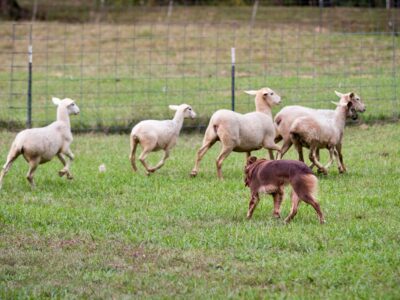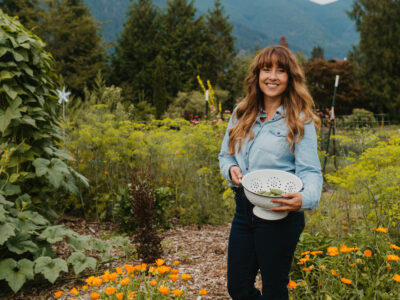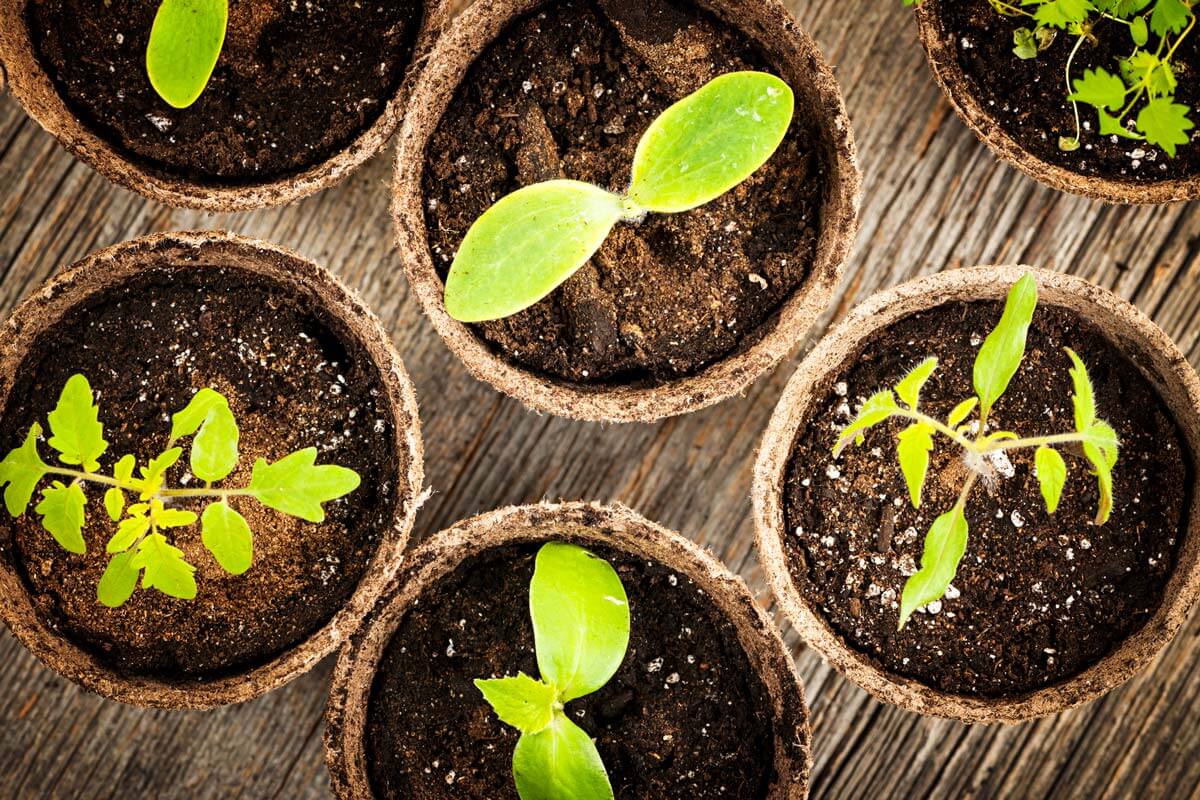Want to grow your own fruit trees? Join me as we discuss not only how to grow fruit trees but how to grow them fast. Learn from this post (and podcast) to avoid costly mistakes in growing fruit trees on your property, as well as which fruit trees are right for your area and when to plant where you live.
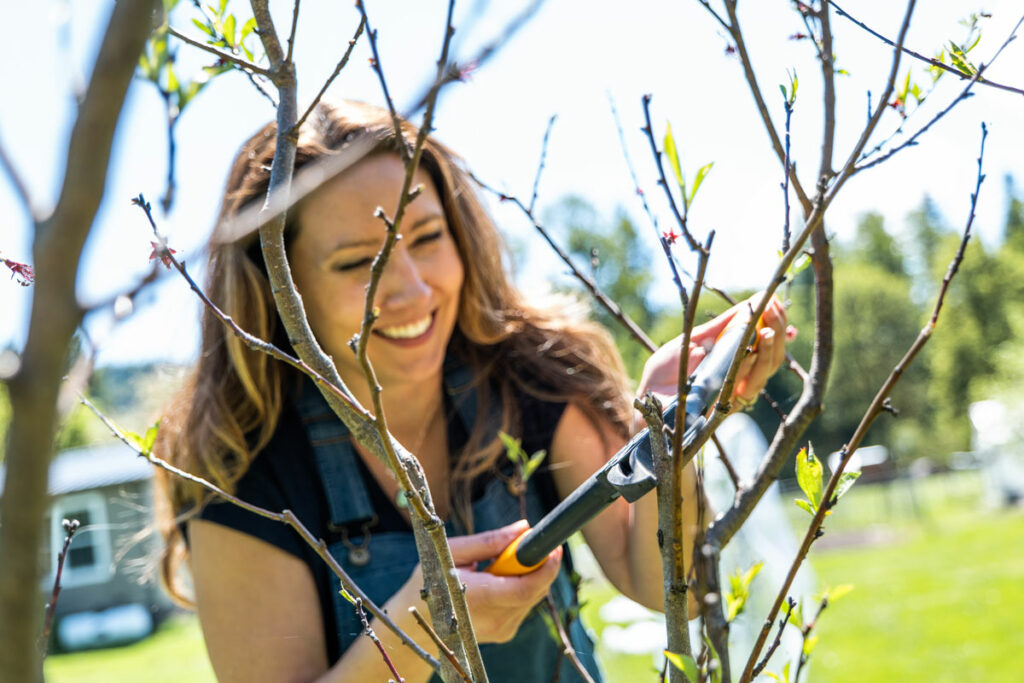
If you’re new to fruit trees, this is a great post to start with. However, you may also want to check out my posts on how to plant fruit trees, how and why to plant a fruit tree guild, how to prune apple trees, how to care for fruit trees in the fall and winter months, how to grow fruit trees in pots (for those of us wanting to grow citrus in the northern climates!), and how to treat your fruit trees for pests (organically).
Between all these posts, you should be growing your own nut trees and fruit trees with great success, no matter where you live.
This blog post has been updated to include multiple podcast episodes. The first is with Angie, a homesteader from Texas with an awesome tool to help you grow your own food. She’s sharing her tips in Pioneering Today Podcast episode #51 – How to Grow Fruit Trees.
Susan Poizner is joining us in Pioneering Today Podcast episode #424 – Growing Fruit Trees Fast! (Embedded at the top of this post.)
You can learn how many fruit trees and berry bushes you need to plant per person in Pioneering Today Podcast episode #230.
And finally, my podcast on 5 Tips to Starting an Orchard which is Pioneering Today Podcast episode #169. As you can tell, I’ve covered this topic extensively. So this blog post is your one-stop-guide for all things growing fruit trees.
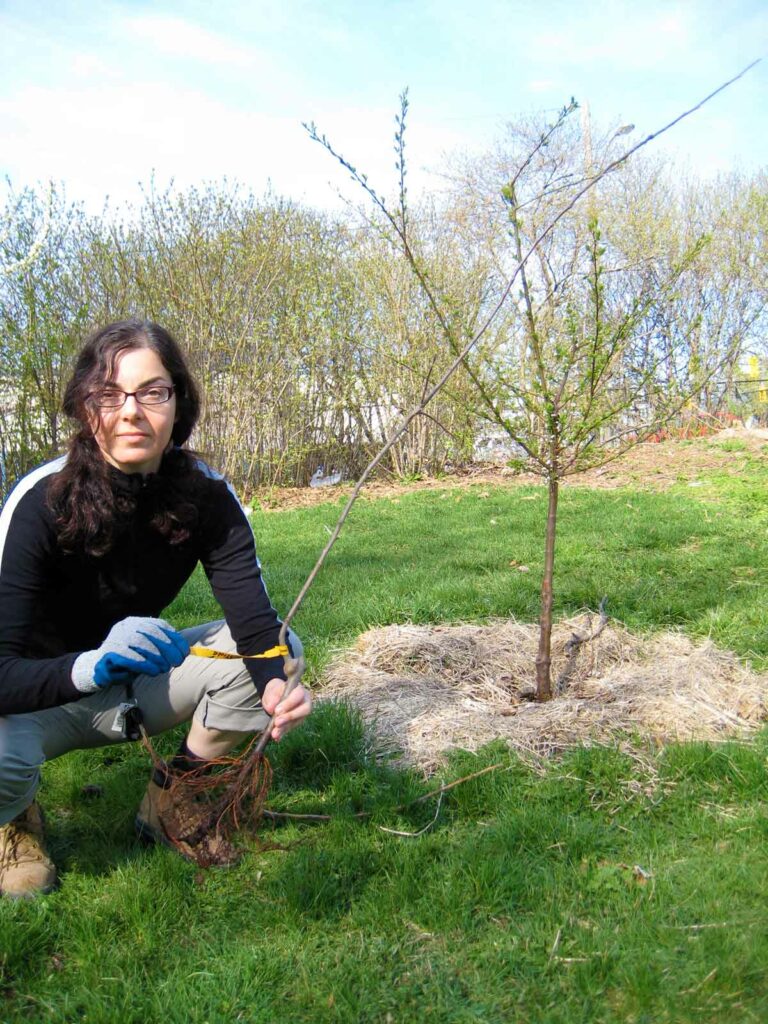
Table of Contents[Hide][Show]
- About Susan Poizner
- Benefits of Planting Fruit Trees
- Growing Fruit Trees From Seed
- Where to Buy Fruit Trees
- Potted Trees vs. Bare-Root Trees
- When to Plant Fruit Trees
- Tips for Getting Fruit Trees to Grow Fast
- Fruit Tree Growing Mistakes to Avoid
- Soil Type & Fertilizer
- Damaged, Diseased or Struggling Trees
- Where to Find Susan Poizner
- More Posts on Growing Fruit Trees
About Susan Poizner
Susan Poizner is an urban orchardist and fruit tree care educator from Toronto, Canada. She’s the founder of the award-winning website OrchardPeople.com. Susan shares insights on organic fruit tree care, food forests, and permaculture.
Her goal is simple: to empower everyone to grow fruit trees successfully. An ISA Certified Arborist, Susan also travels across North America as a keynote speaker, teaching gardeners, arborists and home growers how to grow fruit trees that thrive.
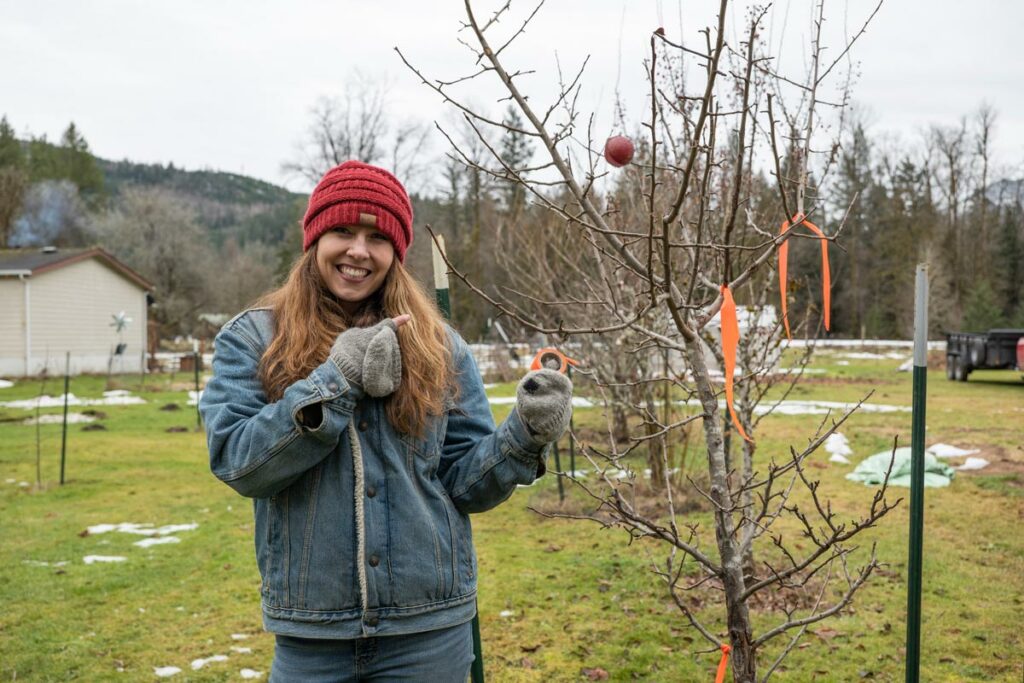
Benefits of Planting Fruit Trees
One of the benefits of fruit trees is that they are perennials. That means we plant once, and year after year after year, it provides us with fruit without us ever having to seed start or plant it again. Now, that’s assuming the right variety was chosen and that it was put in the right spot when planted.
Whether it’s cherry trees, pear trees, peach trees, fig trees or some other kind of fruit tree, I think you’ll find this guide helpful.
Growing Fruit Trees From Seed
I don’t actually like to grow nut trees or fruit trees from seed, and the reason is that you’re going to be adding that many more years before they begin to produce fruit (usually the bare-root trees or saplings you buy at a nursery are already 2-3 years old).
Another reason is that, depending upon the variety of fruit trees, when you plant them from seed, you don’t always get the same variety.
So, to make sure that I’m getting the exact fruit variety that I want, I like to start with some immature, bare-root fruit trees that I transplant precisely where I want to plant them.
Sizes of Fruit Trees
But, first, let’s talk about the different sizes and types. There are three sizes of fruit trees to choose from:
- Dwarf & Miniature
- Semi-Dwarf
- Standard
Dwarf and Miniature
These are the smallest and most compact fruit trees. They usually get between 8 to 10 feet tall and wide upon maturity. The size of the fruit is not dwarf, just the size of the tree.
Benefits of a Dwarf Fruit Tree
- The good thing about a dwarf tree is they sometimes produce fruit sooner than their larger counterparts. Possibly within as little as two years, similar to berries.
- They are excellent candidates for growing in containers.
- You don’t need a ladder, so there’s no climbing. They don’t get super tall.
- They’re easier to prune and maintain.
Cons of a Dwarf Fruit Tree
- They have a shorter life span, usually 15 to 25 years versus the standard variety, which is 50 years plus.
- Smaller harvest. Not because the fruit is smaller, but because the tree is smaller meaning there isn’t as much fruit to harvest from it as you would get from a semi-dwarf or standard variety.
Semi-Dwarf
Semi-Dwarf trees are right in the middle and grow 12 to 15 feet tall and wide. This depends upon the root stock. Some may get a little bit taller, closer to 18 and 20 feet, but on average, upon maturity, you might need a ladder to harvest at the very top of the tree. Semi-dwarf is what we have on our homestead.
Benefits of a Semi-Dwarf Fruit Tree
- Can be grown in containers.
- Provides fruit faster than the standard variety.
- Depending on the variety, you can get double to triple the harvest you would get from a dwarf tree.
- They’ll get large enough to provide shade during really hot times of the year.
Cons of a Semi-Dwarf Fruit Tree
- Smaller harvest than a standard variety.
- Shorter lifespan than a standard variety of fruit tree.
- Requires a ladder to reach the top of the tree for harvest and pruning.
Standard
Standard trees are the big boys. They can reach beyond 25 feet tall at maturity. My parents have apple trees on their property that are over 60 years old and are still producing fruit with very little pruning. They are quite sprawling since they haven’t been pruned in a number of years, but they are still producing pretty decently. My neighbor has an old standard apple tree that has fallen over in the middle of their field and it still produces fruit, even completely laying on the ground. Pretty impressive for something that was planted half a lifetime ago.
Benefits of a Standard Fruit Tree
- Large harvest, so you’ll get plenty for fresh eating, preserving, selling, and sharing.
- They have a long lifespan, upwards of 50 years in many cases.
- They can provide a lot of shade.
Cons of a Standard Fruit Tree
- It takes a few more years longer for the tree to produce a harvest.
- Definitely requires more space per tree. You’ll likely need to have some acreage if you plan on having multiple varieties. Nor do you want them too close to building and structures.
- And you’ll definitely need a ladder for harvest and pruning on mature standard-sized trees.
Where to Buy Fruit Trees
When deciding which fruit tree to grow, it’s not as simple as saying, “Well, I like to buy Honey Crisp apples from the grocery store, so I’ll buy a Honey Crisp tree and eliminate that need.” First of all, Honey Crisp are among the hardest apple trees to grow.
Furthermore, there are certain varieties that aren’t meant to be grown in a home setting; they need pesticides and herbicides in order to do well, and this simply isn’t the route that many home growers want to take. So take out most of the varieties of apples you’d find at the grocery store.
Ignore the big-box stores and, instead, look for disease-resistant varieties that do well in your area from specialist fruit tree nurseries. If you can find a nursery local to you, that’s even better. Susan has a blog post on where to buy fruit trees throughout the United States and Canada.
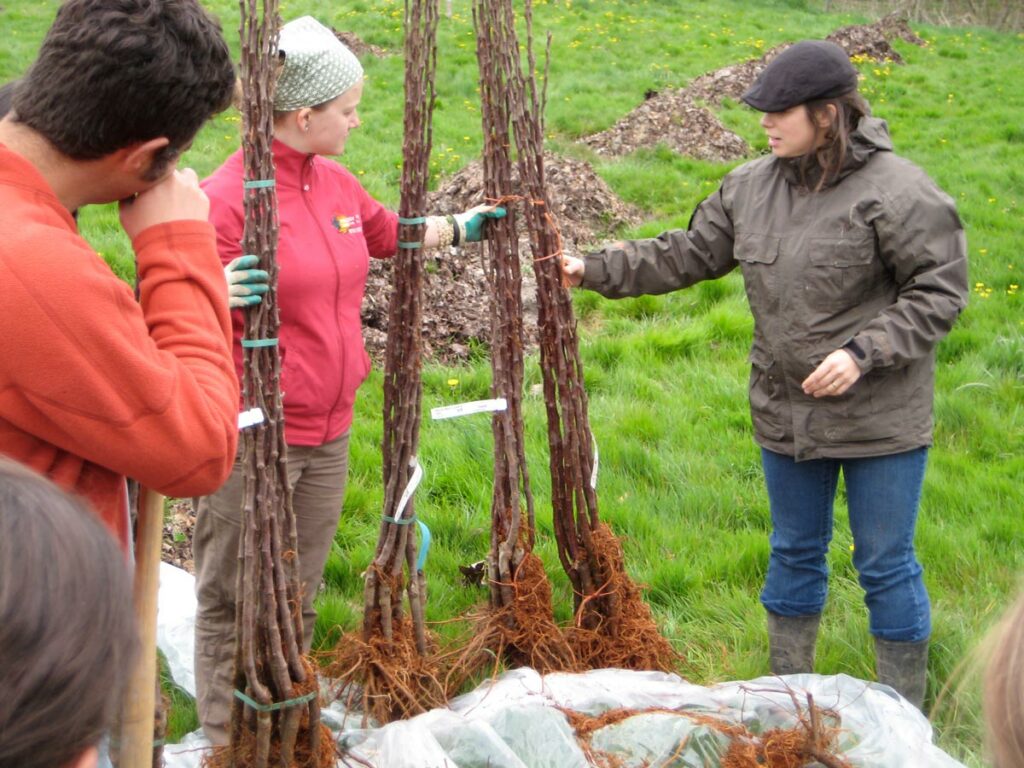
Potted Trees vs. Bare-Root Trees
I asked Susan if she would recommend buying potted trees or bare-root trees. She, without hesitation, said to purchase bare-root trees. Not only are they cheaper, but they’re healthier.
Bare-root trees adapt better to a new environment because their roots aren’t stuck in a pot getting root-bound. They haven’t been spoiled by potting soil, so they tend to bounce back much faster.
When you get your bare-root tree, Susan says to prune off the top third of the tree the day you plant it in the ground. She says it will look very tiny, but what happens by pruning is that the energy goes into the root system instead of pushing out new branches.
My recommendation, if you can visit the nursery yourself, is to sift through the trees and choose the one with the biggest root ball. That tends to give me the best success with my trees.
When to Plant Fruit Trees
It’s important to know the best time of year to grow fruit trees. This will depend on the climate where you live.
- Warmer Climates – For warmer climates, the best time of year to plant fruit trees is in the fall. Ideally, they go in the ground about October or November. Since warmer climates have mild winters, this is ideal. Summers tend to be extremely hot, so we don’t want to burn the trees up. However, a few cold snaps shouldn’t hurt the trees. If you plant in March or April, you may end up losing your fruit trees. They need ample time to develop a good root system before being exposed to extreme heat. So, by planting in the fall, they get about six extra months for root development. If you have no other option than to plant in the spring, be sure to water them deeply and often.
- Colder Climates – For cooler climates, the best time of year to plant fruit trees is in the late winter or early spring. Ideally, they go in the ground between March and May. Since cooler climates have more severe winters, you don’t want to plant a fruit tree in the fall where it will be exposed to multiple freezing nights. However, because you’ll be planting in the spring, it’s imperative to make sure your fruit tree is watered well, especially through that first summer during the hotter, dryer months. Weekly deep waterings are great. This is also why creating a fruit tree guild can be a game-changer for your fruit trees. The mulch will help prevent evaporation from the water and the other plants will help feed the tree.
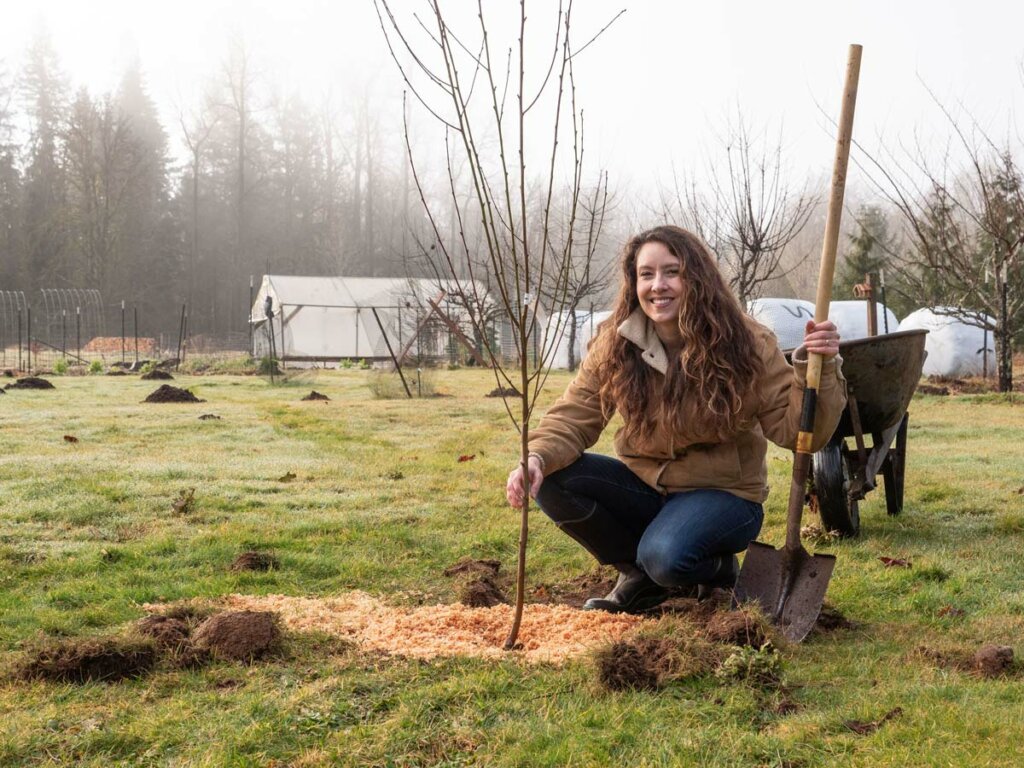
How to Plant Fruit Trees
Digging a Hole
If you plan on transplanting an established fruit tree or fruit plant or planting a bare root or potted tree, be sure you dig the planting hole twice as wide and twice as deep. Create a cone shape of dirt in the bottom of the hole and spread the roots out and down this dirt cone (same technique in How to Plant Strawberries)
Filling the Hole
Backfill the hole with loose dirt and a layer of compost. If any of the roots are broken, remove them before planting. Keep the level of dirt at the same level it was in at the nursery. You can usually see the line on the trunk of the tree or bush.
Create a mote around the base of the tree to allow the water to filter down onto the roots instead of running off into the surrounding soil or land.
Use a small amount of water when you plant the tree. The soil will settle, and you’ll be able to see where you need to add more dirt.
Watering Schedule
Don’t overwater in the winter months. In the late spring, when the tree leaves out, and the soil becomes dry, water deeply 5 to 10 gallons once a week.
Throughout the first few summers, you’ll want to water the plant once a week if you don’t have any rainfall. I neglected to do this with one of our new apple trees and lost it. So even in the rainy Pacific Northwest, you’ll still want to follow the rule of watering deeply once a week with a newly planted tree if there isn’t any moisture falling from the sky.
Note: It takes an average of seven years before you’ll be able to harvest a sizeable crop from your fruit trees. Most bare rootstock is a few years old, but you can ask the nursery for more specifics.
The bigger or older the stock, the more expensive it will be.
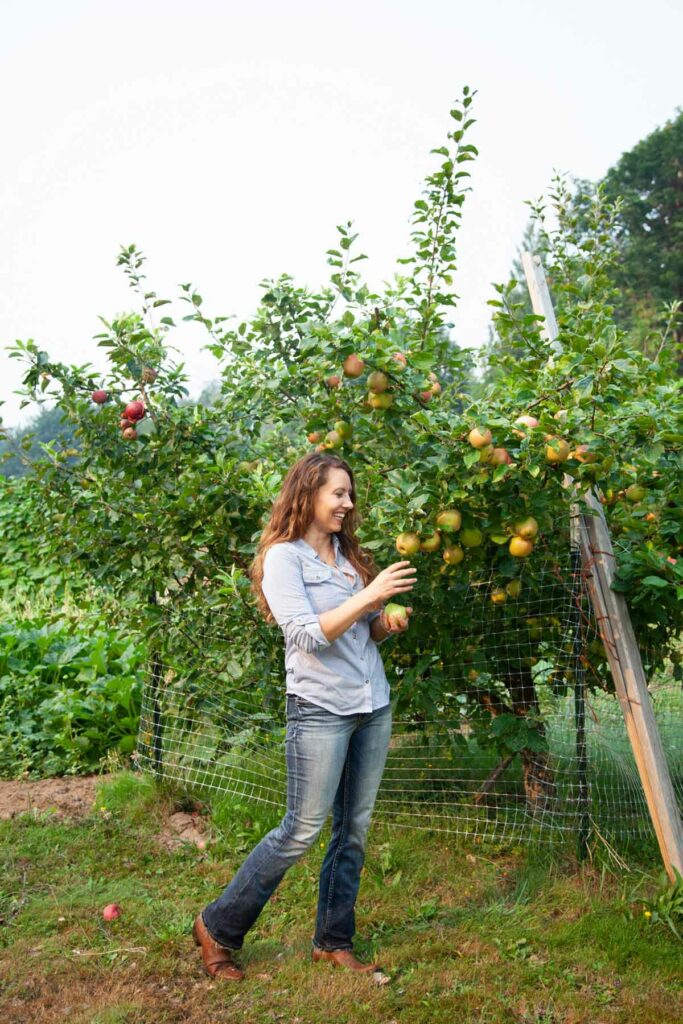
Types of Fruit Trees
When my husband and I first started planting our orchard, we were working with raw, undeveloped land. There were no other existing fruit trees around us. We planted bare-root fruit trees because they’re a less expensive option. However, we didn’t understand the difference between self-pollinating and cross-pollinating trees.
Self-Pollinating
Self-pollinating fruit trees are trees that can make fruit all by themselves. So you only need one. You can have more, but you don’t have to have multiple trees in order to get fruit. It’s really important to know for a small or urban homestead where you don’t have a lot of acreage. It’s nice to know you don’t need multiple trees for fruit.
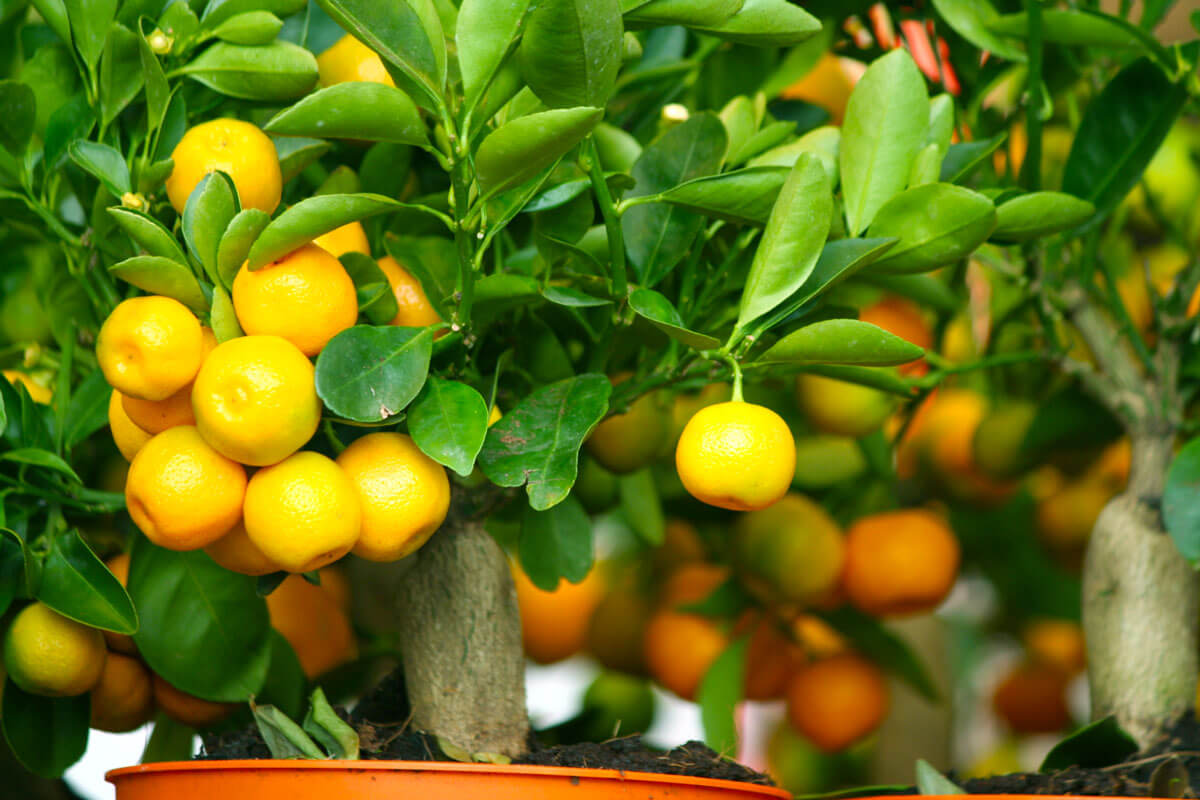
Self-Pollinating Fruit Tree Varieties
- Apricot
- Pomegranate
- Citrus Fruit
- Grapevines
- Persimmons
- Sour Cherries
- Berries*
- European Plums*
* Though berries and the European plum are on the list, they will do better if they have another variety to cross-pollinate with.

Cross-Pollinating
It’s important to note that when you have a “cross-pollinating” tree, it means it needs more than one variety of trees for pollination, not more than one plant. If you plant two or more of the same variety, you won’t get much fruit production.
Be sure your varieties have the same bloom time. In order for cross-pollination to happen, both trees need to be in bloom at the same time. For example, if you have early-blooming blueberries, you need another variety that blooms early for cross-pollination.
If you have a neighbor with a different variety of trees, you should be good to go; however, make sure they’re within 50 feet of one another for cross-pollination to occur.
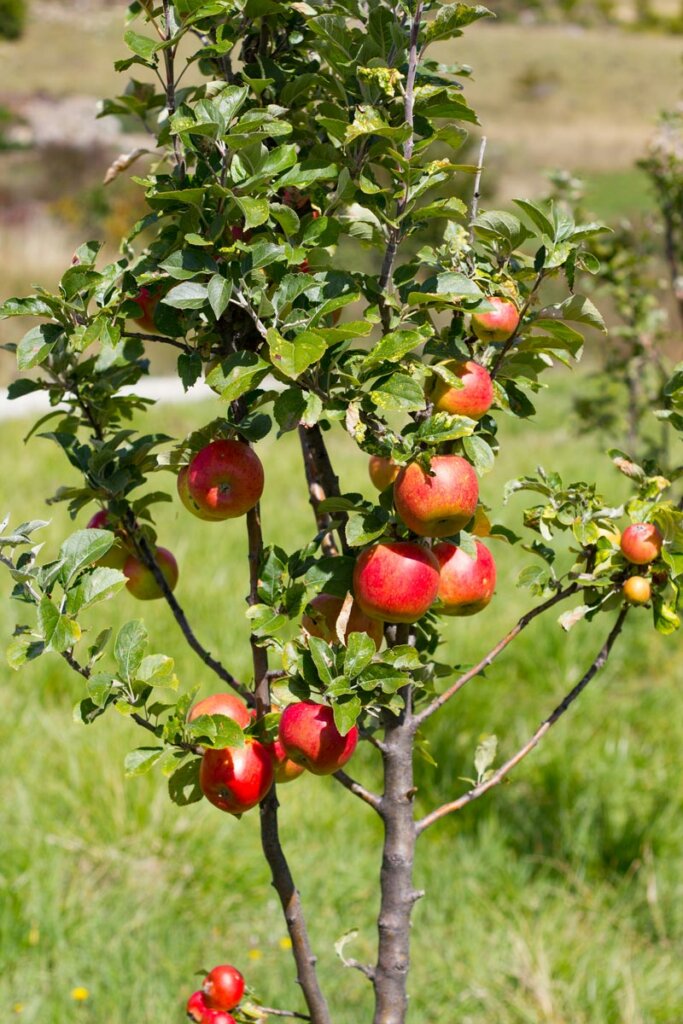
Cross-Pollinating Fruit Trees
- Apple (there are a few self-pollinating varieties like Golden Delicious, but they will still do better if they have a cross-pollinator)
- Pears
- Japanese Plums
- Sweet Cherries
- Most nut trees
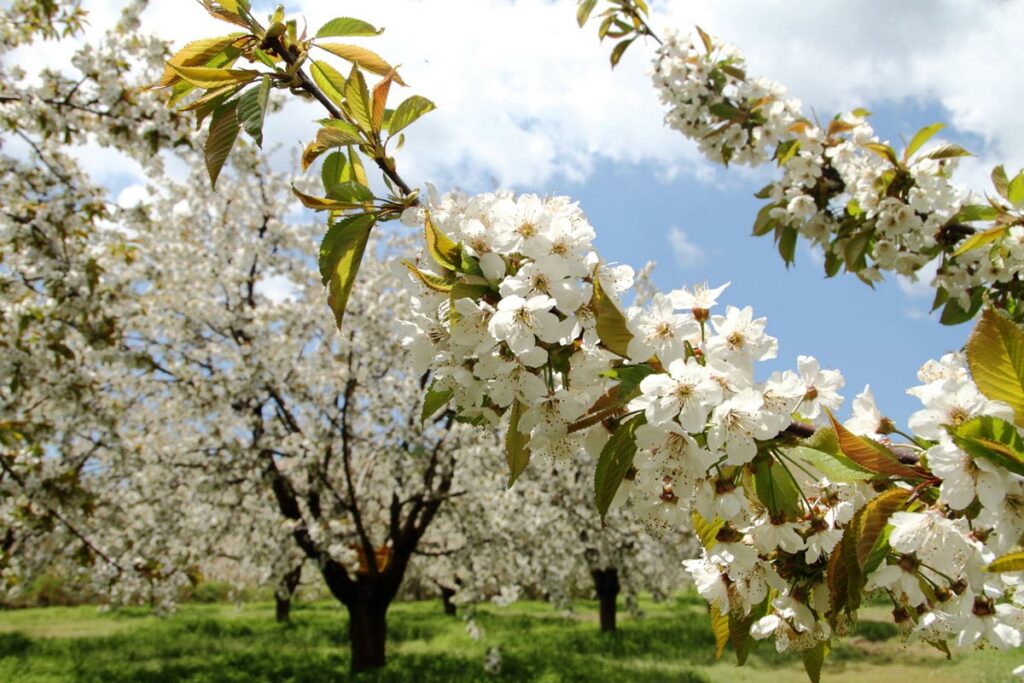
Early-Season, Mid-Season and Late-Season
You need to pay attention to early-season, mid-season, and late-season on your fruit trees. A crab apple is sour and not good for table eating, but it’s a super pollinator because it has a very long bloom time and cross-pollinates with almost every type of apple variety.
We got a crab apple tree for that very reason! The crab apple is also an excellent source of natural pectin, so it’s a great fruit to mix into homemade jams and jellies.
Root Stalk
There’s one more aspect of fruit trees you must be aware of. Fruit trees can grow to varying sizes. If you’re hoping for a dwarf variety, you need to be sure that it’s a dwarf root stalk. You don’t want to purchase an apple tree, thinking it will grow to a certain size, then have that tree take over your entire yard because it was grafted onto a full-size root stalk.
If you’re not sure, it’s always smart to ask.
Chill Hours
Chill hours are hours during the year when the temperature is generally below 45 degrees on average in a region. Certain trees need a specific number of chill hours. If your fruit trees don’t get the required amount of chill hours, there will be little to no fruit production.
You may be able to determine this by your hardiness zone. This is one reason I recommend purchasing your fruit trees from a local nursery as they’re familiar with the climate, chill hours and zones in your region.
Knowing how many chill hours you have in your area and how many chill hours the specific variety of trees needs is important. Reach out to your local extension office or consult with a professional horticulturist to make sure you get plants that are going to work for you and your area.

Fruit Trees
Now that we have our quantities explained, let’s dive into how many fruit trees are needed, per person, to grow a year’s worth of food?
NOTE: The following averages are for one mature fruit tree for each type of fruit listed. Trees that aren’t mature will yield a lower harvest.
Apple
- Dwarf: 5 to 6 bushels
- Semi-Dwarf: 10 to 15 bushels
- Standard: Anywhere from 5 to 20 bushels
Apricot
- Dwarf: 1 to 2 pecks
- Semi-Dwarf: 1 to 2 bushels
- Standard: 3 to 4 bushels
Cherry, Sweet
- Dwarf: 8 to 10 gallons
- Semi-Dwarf: 10 to 15 gallons
- Standard: 15 to 20 gallons
Cherry, Sour (aka Tart or Pie Cherry)
- Dwarf: 3 to 5 gallons
- Semi-Dwarf: 12 to 18 gallons
Nectarines
- Miniature: 1 to 2 pecks
- Dwarf: 3 to 4 bushels
- Standard: 6 to 10 bushels
Peach
- Miniature: 1 to 2 pecks
- Dwarf: 3 to 4 bushels
- Standard: 6 to 10 bushels
Pears
- Dwarf: 6 to 8 bushels
- Standard: 12 to 15 bushels
Plum, European
- Dwarf: 1 to 1 ½ bushels
- Standard: 1 to 2 bushels
Plum, Japanese
- Dwarf: 3 to 4 bushels
- Semi-Dwarf: 4 to 5 bushels
- Standard: 5 to 6 bushels
In reviewing these, you can really tell that based on the type of tree the actual production can vary greatly. For example, the difference between the dwarf and standard apple tree is a big difference, from six bushels for the dwarf to 20 bushels for the standard. But when you look at the Japanese plum the difference is really only two to three bushels difference.
What you need to do now is calculate how many bushels your family will consume of each variety of fruit.
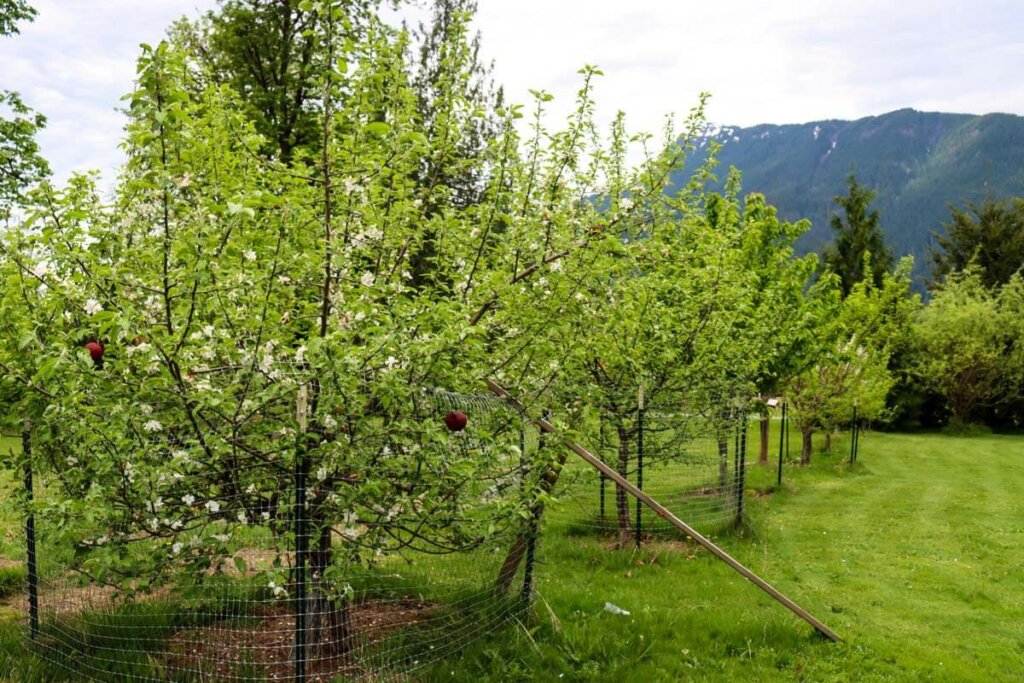
Tips for Getting Fruit Trees to Grow Fast
When planting new fruit trees, we’re all very excited for the tree to begin producing fruit. That’s the whole point, after all, right?
However, your tree will be better off if you follow these simple tips when planting a new fruit tree, and you’ll end up with a healthier tree, faster fruit production and more to harvest:
- If you want fruit trees that will produce fruit faster, choose stone fruits. They are much faster than pear or apple trees in regards to production.
- When choosing fruit trees from a catalog, look for the words “vigorous” and “precocious.” Vigorous tells you that the tree is fast-growing, and precocious tells you that the tree will produce a harvest sooner. A precocious tree will give you fruit in the second or third year, whereas one that’s not precocious may make you wait until year four.
- Purchase bare-root trees from a specialist fruit tree nursery (avoid buying from big box garden centers).
- Soak the tree in a bucket of water for up to 30 minutes before planting. That will help the tree get nice and hydrated before planting into the ground. Though the tree will likely be in dormancy at the time of planting, it still needs water!
- Do a soil test prior to planting and amend the soil with fertilizer (the ideal fertilizer or soil amendments should come with the growing guide for the tree).
- Know the best location for planting your tree. Does it need full sun, partial sun, etc. Also, consider the size of the tree at full growth. You don’t want it shading out your vegetable garden once it’s full grown and leafed out.
- Make sure the graft root is above the soil line and avoid any air pockets from remaining in the soil (this can cause air pruning of the roots which will slow down growth).
- Plant the tree right away and prune the “whip” (the top 1/3 of the tree) the day you plant it. Pruning fruit trees always seems counterproductive, but trust me on this one!
- Water the trees properly. Fruit trees want deep watering that gets down to the roots. Overhead watering or using a sprinkler that gets the foliage of the tree wet can lead to disease.
- Don’t allow the tree to fruit the first year. Allow them to blossom (to help the pollinators), then pinch the blossoms off so they don’t produce fruit. This will help establish a strong root system for the fruit tree.
- Prune them heavily the first few years to establish the roots and the tree’s shape. This also promotes good air circulation and a strong canopy where every branch gets access to equal amounts of sunlight.

Fruit Tree Growing Mistakes to Avoid
- Not planting a bare-root tree right away. Even letting the tree sit out in the sun for an hour or two can cause the blossoms to open up and the roots to dry out and die. If you can’t plant it right away, put it in a cool, dark, damp place (ideally in soil) until you can plant it.
- Don’t plant them too deep! Most fruit trees are grafted. There is a graft union where the top part of the tree is grafted to the root stalk. If you bury the graft union, you can get a full-sized tree when it was meant to be a dwarf tree. The graft union can actually grow roots above the union. You can even get rot on the graft union. So, be sure to keep the graft union above the soil line.
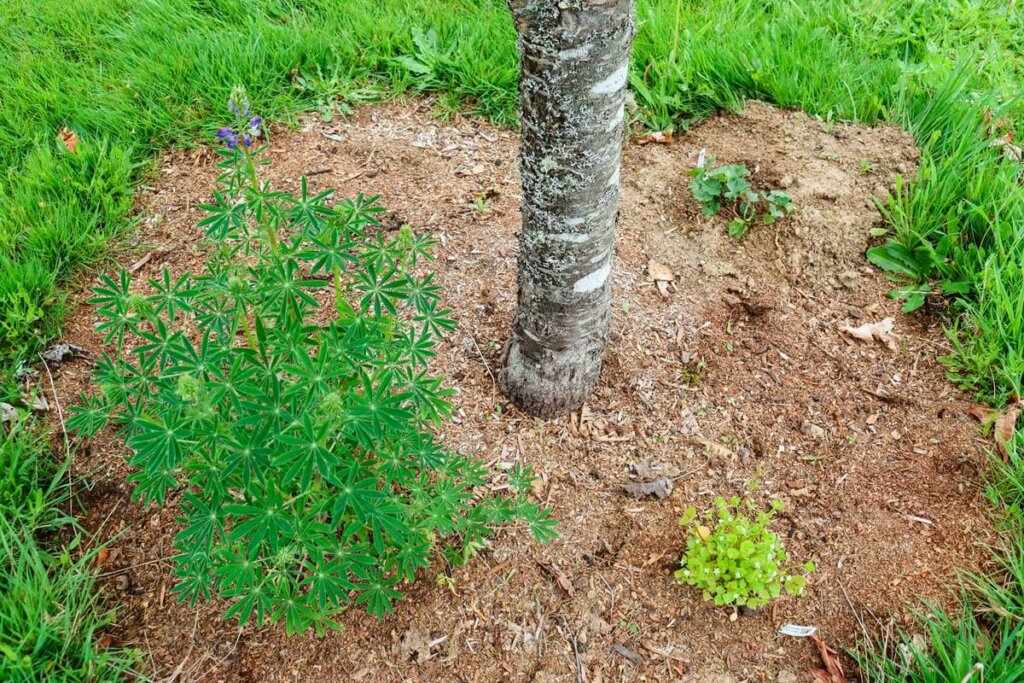
Soil Type & Fertilizer
Thankfully, fruit trees are not as picky when it comes to soil as, say, berry bushes or vegetables. You don’t want to give your fruit tree anything before you know what it needs. You won’t know what your tree needs until you test your soil.
If there are any major nutrients lacking, then you can amend the soil within the first year. Also, check the pH of the soil to make sure it’s around the right pH for your fruit tree variety.
Every year, before the buds break in the springtime, it’s the best time to add some compost and mulch to the base of the tree.
The tree has enough energy stored in the root system for branch growth and fruit production, but once those nutrients are used up, they need to be replenished. We do this by adding a two-inch layer of compost at the base of the tree spreading out to the edge of the canopy. It doesn’t matter how old your tree is. The feeder roots are at the edge of the tree around the drip line.
Avoid nutrient spikes with synthetic fertilizers for your tree. These are not healthy for the tree or the environment.

Damaged, Diseased or Struggling Trees
Don’t dispair if you have a fruit tree that’s struggling. Susan says there is a lot you can do to rehabilitate a tree and bring it back to its full fruit-producing glory.
- At the correct time of year, start with a good pruning to open up the canopy, removing no more than 25% of the tree in one year.
- If your tree has a disease, you want to try and remove the diseased, dead or dying branches by pruning.
- If your tree has a different disease, there may be other methods for fixing the problem.
- Knowing the seven different fruit tree diseases will take you very far in protecting your trees. I’m hoping to have Susan back on the podcast to dive deeper into this topic, so stay tuned for that.
For now, to learn more, grab a copy of Susan’s book Grow Fruit Trees Fast. It will take you about an hour to read and you’ll learn so much about growing fruit trees for your home garden.

Where to Find Susan Poizner
You can find Susan on her website, Orchard People. While you’re there, be sure to check out her course on fruit tree care (coupon code “MELISSA” should be automatically applied for a discount). She also has a radio show and podcast, Orchard People, and find her books at the links below:
You can also find Susan on Facebook and YouTube.
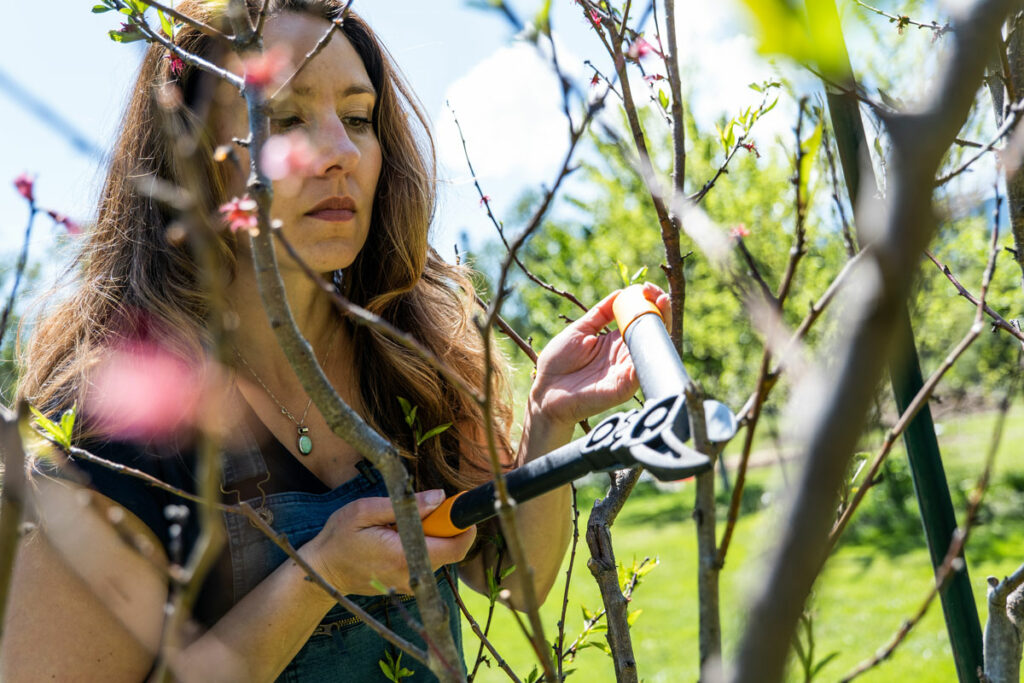
Now that you know how to grow fruit trees in your garden, whether you’re a beginner, planting a young tree or a mature tree, you should be armed with the knowledge needed for ample fruit production for years to come.
More Posts on Growing Fruit Trees
- When to Plant Fruit Trees in an Orchard
- How to Care for Fruit Trees in the Fall and Winter
- How to Treat Fruit Trees Organically for Pest Control
- Utilizing Fruit Tree Guilds
- How Many Berry Bushes and Fruit Trees You Need to Plant Per Person
- How to Prune an Apple Tree in Winter
- 5 Tips to Starting an Orchard and Growing Fruit
- Growing Fruit Trees in Pots
[fusebox_transcript]

